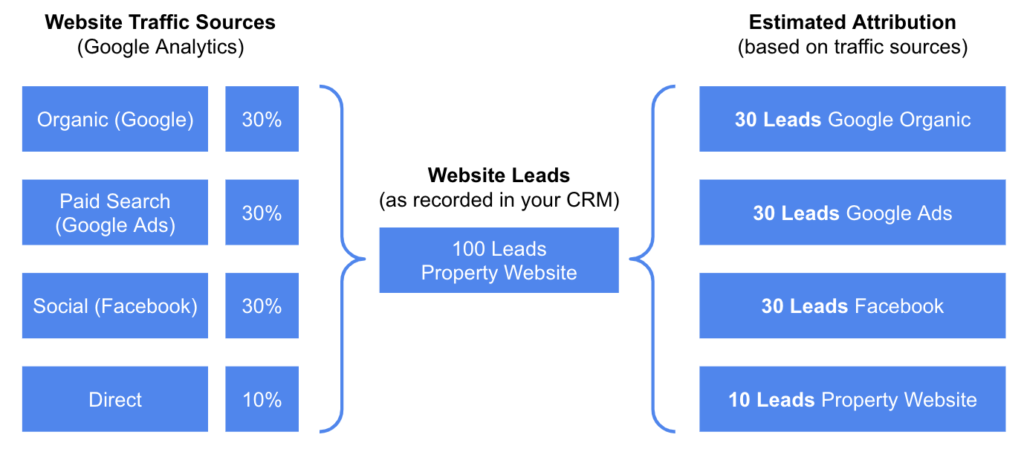5 Tactics Multifamily Marketers Can Apply Today to Increase ROI on Their Portfolio

As a multifamily marketer, you have a tremendously important and challenging task at hand. Generating the necessary traffic to quickly lease-up the buildings in your portfolio and then maintain stabilization amidst constantly changing external factors. Furthermore, you must always be looking for ways to increase the ROI of your marketing campaigns and tactics for your properties. While historically marketing may have been undervalued as creative overhead, it is increasingly being seen and recognized as a critical lever in the asset management function, which means pressure has never been higher.
Understanding which of your marketing channels and tactics are most effective via a data-driven approach, combined with the right tech stack and obsessive measurement will almost certainly help you impact ROI in a meaningful way. Read on below for specifics on how to improve your team’s contribution to ROI!
1. Use a data-driven approach to lead tracking and attribution
Having a clean and accurate database will make your life much easier when it comes to evaluating the performance of your marketing initiatives and making budget reallocations to optimize spend and improve performance.
Lead Source
First thing’s first: make sure all your leads have a lead source. Keep an eye on vague values such as “blank,” “Manual,” “Walk-In”, or the dreaded “Property Website”, and try to minimize their presence in your database.
One way to go beyond “property website” and estimate the source of your property website leads is to distribute those leads to traffic sources identified in Google Analytics, according to their contribution to the overall website traffic.
For example, if your traffic comes from Organic (30%), Paid search (30%), Social (30%), and Direct (10%), and you have 100 leads with Property Website as a source, then you could re-attribute those 100 leads as follows: 30 Organic (Google) leads, 30 Google Ads leads, 30 Facebook leads, and 10 Direct Traffic Property Website leads.

UTM Parameters
Don’t forget to make good use of UTM parameters for complete tracking, and make sure both your website and CRM solution support UTM-based lead attribution. Your CRM should be able to automatically take UTM parameters associated with an incoming lead, and assign or even overwrite the lead source based on the utm_source parameter.
To add consistency to your attribution efforts, try to create a naming convention for your UTM parameters. It will be much easier for your team to identify and report on your marketing initiatives with a clean and logical naming pattern to follow, and it’s never too late to start doing this.
There are 5 parameters you can include in your UTM tracking efforts, but the three most important ones are as follows:
- utm_source – tells you where the traffic is coming from; it could be Twitter, LinkedIn, Google, website, and so on;
- utm_medium – this identifies the marketing medium, which can include email, paid search, CPC, blog posts, comments, and so on;
- utm_campaign – the reason you’re sharing the link; it could be a paid search campaign, an ad based on a blog post, an email marketing campaign, and so on. Give your campaign a specific name that helps you identify it instantly, and differentiates it from other campaigns.
Other optional parameters you could include in your UTMs are:
- utm_term – this parameters is only used for paid traffic campaigns, and can help you identify the audience or the campaign level (e.g. the ad set in Facebook or LinkedIn);
- utm_content – this is used exclusively for paid campaigns, and it helps you identify the ad itself and its contents; it can be either the name/headline of the campaign or something related to it (e.g. ‘blue logo ad 2021’).
Make sure all your UTM parameters are written down in lowercase, so that you don’t end up with UTMs with similar or duplicate names, use dashes between words, and never use the same values for different parameters (such as Facebook for both source and medium) in the same URL, to avoid reporting confusion.
2. Zero in on your audience
For each of your properties, your team has probably created a target persona or an ideal renter profile that you want to reach with that property. A renter persona may include targeting characteristics like interests, hobbies, employers, and even personality traits.
However, even if you don’t have formal personas created for your target renters, you still have a good sense of the type of renters your property is most suitable for. Use those traits to make sure your incoming leads match your target audience – at least for the website and social media strategy, as CRMs are unlikely to have this data. Here are some more things to keep in mind when defining your target audience:
- Google Analytics Affinity & Interests categories should match the interests of your personas

- If you have a social media presence, your followers’s interests should match those of your personas as well.
3. Enable transparency when it comes to channel performance and costs
Devising your marketing strategy will involve a lot of fine-tuning, and you’ll have to keep tabs on your budget and spending to pinpoint what works for your business goals and what doesn’t.
To get a good understanding about which channels perform better, you should have transparency into lead acquisition costs by channel, as well as the conversion rates for each channel. This will allow you to calculate return metrics per channel (ROAS or channel ROI), which will inform how you reallocate budgets to optimize performance and maximize spend.
True ROAS and ROI
As marketing’s role in our industry and the value that it can deliver changes, we also need to evolve our thinking into true ROAS and ROI, which comes from being able to answer more rigorous questions. Not only asking questions such as “How many leases did we get from what sources?“, but more importantly, understanding the value of those leases based on the monthly average rent or duration, and corresponding payback. Once you start optimizing your LTV/CAC (lifetime value to customer acquisition cost) ratio by channel instead of just focusing on how many leads or leases a source is generating, is when your marketing efforts and campaigns will truly start calculating ROI.
Once you have a detailed analysis of channel effectiveness, then you can begin to optimize. This might include adjusting audience targeting for lower conversion sources, shifting spend from sources that are consistently producing high cancellation and denial rates, or re-allocating spend to channels that are proven to generate the highest value leases for the longest duration terms.
Just as you need to constantly monitor and tweak your budget and channel strategies, you also need to adjust and refine your target persona, if needed. Take another look at who you’re trying to reach with a particular property (as highlighted in the previous step) and keep adjusting to make sure you’re targeting the right people.
4. Consider your omni-channel marketing strategy when reallocating budgets
Based on the previous step, you should have a good sense of the baseline return each of your channels brings. Shifting budgets between channels also depends on your renter persona and your overall omni-channel marketing strategy, and you may need to maintain budgets on channels that are not producing leads directly, but are contributing to the awareness or even consideration stage of your renter journey.
For instance, your social media activity might be indirectly boosting your brand, bringing traffic to the website, and helping create a community of followers and even industry connections. You shouldn’t ignore social media and put it on the back burner simply because it’s not bringing you direct leads. Your target audience might be among those Facebook followers, or even on LinkedIn, which can be a viable channel for those offering corporate housing, and some of these followers might turn into leads down the line.
Keep things like brand awareness, brand exposure, trustworthiness, community, and visibility in mind when reallocating your marketing budget, and don’t narrow your vision to only focus on lead-generating channels. To achieve success, you should use all the tools in your digital marketing toolbox.
5. Set goals and measure progress
To increase your ROI, you must first know where you currently stand – keep this in mind before you start devising any kind of marketing plan or strategy. It’s easy to miss the mark and set unrealistic goals when you don’t have a clear picture of your current situation, so take time to evaluate and analyze what you currently have underway via development of a baseline.
After you’ve done this, then you can start looking forward and decide what needs improvement and where you should focus your efforts. Having a clear goal to aspire to can also bring focus and motivation to your team, and help you get there faster.
Based on the data you already have, such as acquisition, costs, average conversion rates and lease velocity, alongside your set budgets, you should be able to estimate when your ROI/occupancy goals will be achieved.
Measure your progress along the way, and see if you are on track or if you need to make adjustments to your strategy, budgets, and channels. Never stop tweaking and fine-tuning things: this is the secret to a successful, forward-looking marketing strategy.
Accelerate your multifamily marketing efforts with Remarkably
Doing all of the above will likely trigger meaningful changes to your ROI. Having the right tools at your disposal can help automate and simplify these processes, and help you make the best of available marketing tools and strategies to drive revenue.
You can rely on Remarkably to reduce workload, and save hours of busywork each week, increase productivity, and optimize marketing spend, so you can focus on refining your marketing strategy and maximize your team’s contribution to ROI.
Reach out to Remarkably to see how we can work together to accelerate your marketing efforts thereby driving higher leasing revenue, more efficiently, at lower cost, with better ROI.



